Many professional and amateur racers have chased after their record-breaking dreams on Bonneville’s salt flats. Mike Kilger, owner of Kilger’s Kustom Metal is setting out to do the same at next year’s Speedweek in a custom-built 1929 Ford highboy roadster on deuce rails. Speedweek is the grand finale of all Land Speed Racing events which occurs in the third week of August and this year marks the 60th anniversary.
Designers Mike Kilger and Al Simon will push the limits of their mechanical and fabrication abilities to craft a beast of a machine capable of breaking the 282-m.p.h. record potentially hitting 300-m.p.h. in the A/B/F/R Fuel Roadster Class. This class covers all 500 cubic inch, blown fuel Roadsters.
To reach this goal, Mike and Al face a challenging build. The roadster will feature a mix of mild steel and aluminum body components built around a 570 cubic-in. twin-turbo Chevy big block engine. Kilger and Simon will rely on the flexibility of their Millermatic® 350P MIG welder to tackle the mild steel custom chassis, roll cage and low-profile seating. They will use the 350P’s pulse MIG capabilities to ease the fabrication of the aluminum hood, cockpit panels and stainless steel fuel and water tanks. They’ll use a Syncrowave® 180 to tackle the required TIG welding and a 18-lbs. Spectrum® 375 X-TREME™ plasma cutter for precision cutting.
Just Fast Enough to Scare You
Since its inception in 1949, the Bonneville salt flats continue to draw racers throughout of the racing community. The wide-open flats offer a relatively safe place to race, cutting down on the dangers and fatalities associated with street racing. Sanctioning classifications and regulations set by the Southern California Timing Association (SCTA), further improve the safety of the sport while providing direction for vehicle fabrication. Today, Bonneville has become a meeting ground for friends and family who share a passion for good times and fast cars. It’s one of the last places where anyone can race any type of vehicle without the pressures of getting a national sponsorship and one of the only places in the world to conduct long-distance land speed racing.
“You go out there and you never know what you’re going to see,” states Kilger. “It could be an old Peterbuilt truck going 280-m.p.h. or a 1951 drop tank kicking up salt.”
The salt bug bit Kilger twelve years ago. Along with Simon, they have both spent some time racing in a variety of roadster classes until they found their calling. The Roadster Class is one of the largest divisions of competition. Its popularity can be attributed to a long history at the dry lakes and Bonneville Salt Flats.
“There are a lot of different roadster classes: modified roadster, rear engine modified roadster, fuel roadster,” says Kilger. “Some racers are really set in their ways, running old flat heads and nostalgia motors that have been racing the flats for years.”
Competing in the Gas Roadster division, Simon, Kilger and their long time friend and build partner Keith Erickson will get to race in the car when it’s complete. SCTA regulations require all drivers to get their 125-, 175- and a 200-m.p.h. license pass to race on the salt flats.
“There will be those white-knuckle moments that get the blood pumping,” comments Kilger. “Through all the excitement, it’s all about safety out there.”
A number of design and fabrication elements will be incorporated into the build, keeping the car as safe as can be in its 300mph attempt.
Heavy and Fast
Until now, Kilger and Simon have been tight-lipped regarding the design. As any good racer will do, they don’t wish to tip their hand to the competition, and, although they are playing within the SCTA regulations they don’t want to let out any design secrets.
Weight is one of the most important factors in the build. Running a heavy car helps to get the power to the ground, increasing traction and control of the tires. With surface winds sometimes reaching 60mph, keeping the car straight under the increased speed and ground conditions is the most mentally and physically taxing part of the run. The technical driving and design of the car must work together.
“We want to build a classic 1929 highboy roadster on deuce rails using an all-steel Brookville body and American Stamping rails,” comments Kilger. “We want to make it look simple, like it came out of 1948, but with a little more power tucked inside.”
Under the hood, the car will feature a 570 twin-turbo big block Chevy engine running on 80- to 90-percent nitro with a Super T-10 4-speed transmission and a quick charge rear end. The chassis and body components will all be built around the engine, requiring a lot of custom welding and fabrication, something Al Simon has experience in.
Al Simon and Mike Kilger used to work together for the late Boyd Coddington in his hot rod shop, Hot Rods by Boyd, and have picked up a few fabrication tricks in their years together. Such as the car needs to be heavy enough to stay on the ground and still look like a classic highboy roadster, 5,000 lbs. is not uncommon.
“Ideally, the center of the weigh should be very low and in front of the rear-end,” states Simon. “Our design does this, placing the weight right behind the driver’s seat, which sits down along the left side of the drive shaft.”
The chassis is fabricated from 1- and ¾ in. mild steel DOM tubing with quarter-wall cross members. The floor will be made from 1/2 –in. plate. There isn’t a specific weight regulation, but there are specifications for the length, height and wheelbase.
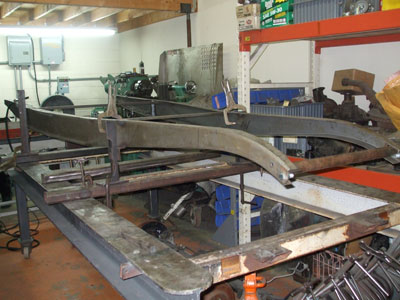 |
|
As he makes his early measurements, Simon is careful to make sure the completed car won’t be more than 143 inches long from the grille to the tail. A miscalculation would mean disqualification of the car, weeks spent re-fabricating and a bruised ego.
|
Simon plans to straighten, elongate and lower the front-end. The back-end will be lengthened and re-pitched into the rear of the car increasing its stock 106-in. wheelbase up to 119-in. He’ll do this by modify the existing 1932 Ford rails from American Stamping to his own design, keeping the length under the 143-in. regulation. A longer wheelbase helps keep the car moving straight and easier to control at high speeds. Only five feet of the original rails will be used. The new front and rear sections will be cut, bent and welded in to Simon’s design.
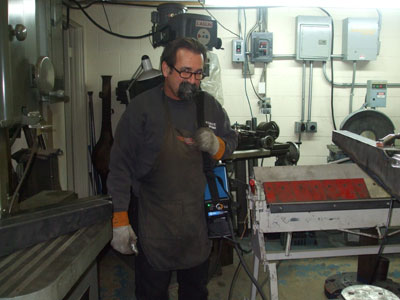 |
|
While crawling around a chassis in an already jam-packed 1,000 square-foot shop, Simon appreciates the portability of his 18-lbs. Spectrum 375 X-TREME plasma cutter. It is lightweight enough to go where he does—around the shop or to the salt flats. The ability to connect to 115 or 230 V power is beneficial for transporting, and with its 3/8-in. rated cutting capability, Simon can easily tackle the chassis cutting.
|
“I do a lot of welding and fabrication at night and early in the morning because that’s when the power is really good,” recalls Simon. “In the summertime at about 3:00 p.m. everybody would turn their air conditioners on. There was no power for welding or cutting.”
The Spectrum 375 X-TREME handles power fluctuations more efficiently so Simon does not have to wait. It is much less susceptible to nuisance breaker trips in the shop because of its ± 15 percent line voltage compensation feature and power factory correction technology (which reduces draw from 34 to 28 amps). This feature maintains a constant power output to Simon’s plasma cutter, regardless of the fluctuations in input power common in his Riverside Calif. shop.
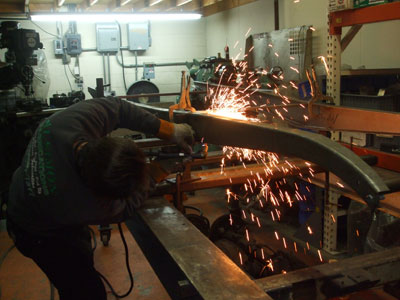 |
| Measure three times, cut once. To get that professional straight edge, Simon recommends using a guide clamped to the work piece and maintaining a 1/8-in. distance between the metal and torch tip as you make a steady pass. |
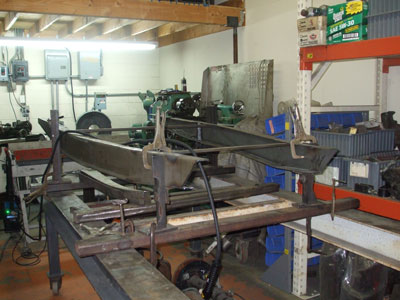 |
| After the first rail was removed, Simon moved to the other side, once again, measuring three times and cutting once to ensure both sides are trimmed to the identical length. Next, Simon used a cardboard template to mock up the new elongated rails. He then took the template to a shop where a press-brake formed the rails to his specifications out of ¼-in. plate. |
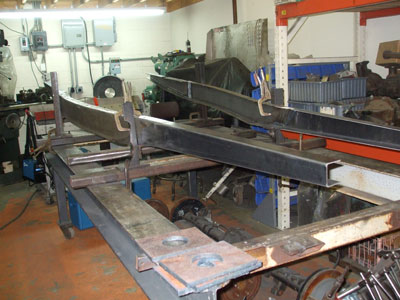 |
| The freshly cut rails are welded to the original structure using a Millermatic 350P MIG welder. Simon uses a 75-percent argon, 25-percent CO2 gas mix and runs .035 mild steel wire to weld the ¼-in. plate to the 1/8-in. original. |
The pulsing ability of the Millermatic 350P will come in handy later on in the build while skinning the car. When appearance of the weld bead is important, the pulsing feature has no equals. Pulsed MIG produces little, if any, spatter, unlike short-circuit MIG. A pulsed MIG bead can resemble a TIG bead. As a result, the time spent finishing certain components of the car may be reduced or eliminated.
The Millermatic 350P provides numerous other benefits over regular MIG machines—faster travel speeds, higher deposition rates, efficiency, lower fume emissions, energy savings, and all-position welding.
Pulsed MIG is an ideal process for the all-position welding found in building a car because the weld puddle has a chance to cool and freeze slightly, and a faster-freezing weld puddle provides better control on overhead and vertical welds so the puddle doesn’t “roll-out” for the joint when welding out of position such as on the side of the car.
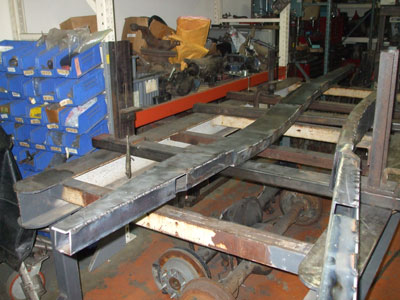 |
|
Next, Simon boxes the rails to make them more ridged and increase the weight. The rear rail horns, seen here, were designed with open pockets that will be filled with lead shot. The lead is another secret for increasing the weight and stability down to the tires. Simon applied quick tack welds every 1 and ½-in. before coming back around with a stitch weld.
|
|
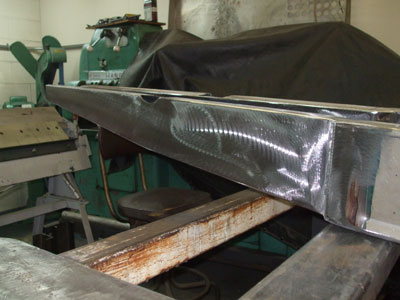
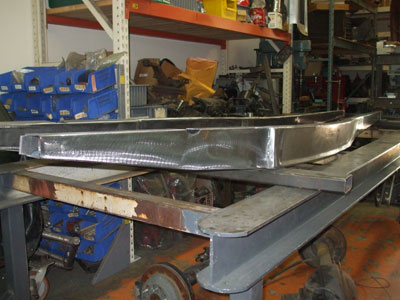
|
|
Blend grinding finishes the modification and adds a nice sparkle. The rail horns were fabricated to taper up into the rear of the car. This will allow the airflow to be expelled quickly from underneath the car at fast speeds.
|
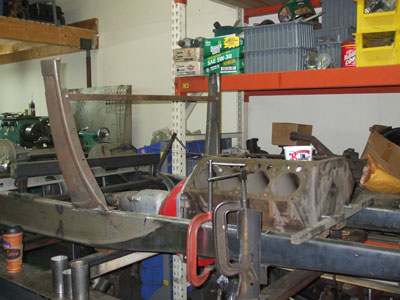 |
|
The roadster cowl that will eventually straddle the firewall is tacked into place and a mock engine and tranny is dropped in.
|
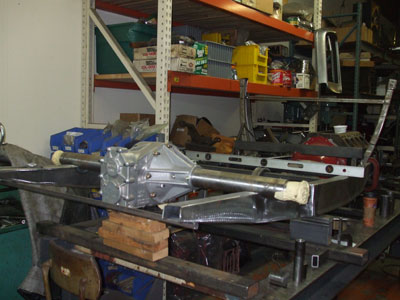 |
|
The rear differential slips in square and balanced, the sign of a successful chassis modification. Next, Simon uses the Syncrowave 180 to weld in the remaining cross members. The body panels ordered from Brookville Roadster are delivered and mounted to the chassis.
|
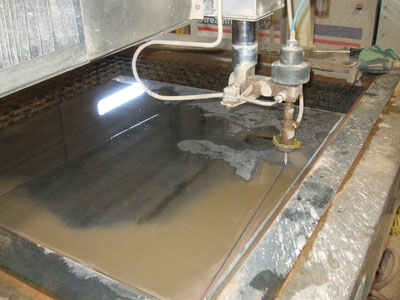 |
|
To add more weight to the front-end, the step pan is fabricated from a single piece of ½-in. mild steel plate that was cut using a water jet at BK Customs of Riverside Calif.
|
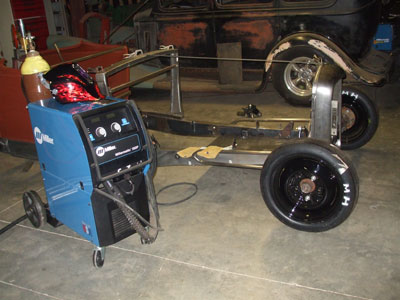 |
|
Kilger uses the Millermatic 350P to weld mounting tabs for the hefty step pan placed at the front of the car.
|
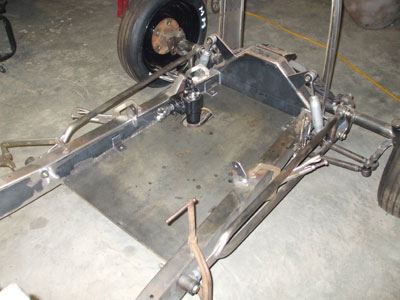 |
|
The installed step pan has a large hole cut out for the installation of the Vega steering box from Borgesen Mullins.
|
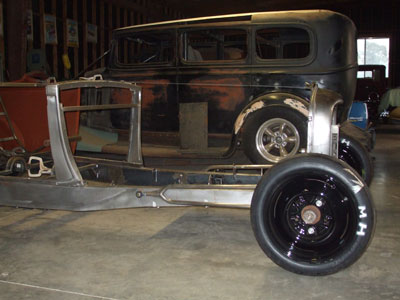 |
|
Al made the front hairpins seen here from 1-in. half-inch wall DOM tubing. The hairpins align the front-end and mount to the lengthened and boxed rails.
|
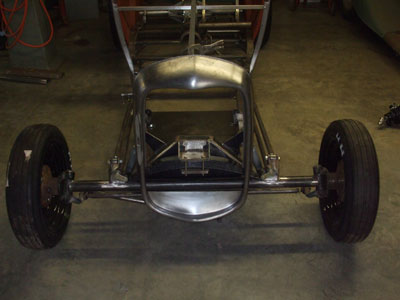 |
|
The Brookville front grille and custom leaf spring designed by Simon is mounted. The axles, wheels, steering arm and front tie rods are also installed. The front was designed to keep the car as straight as possible.
|
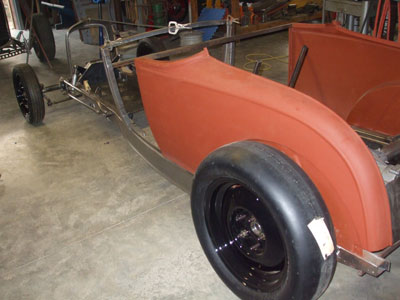 |
| The 1929 Brookville Roadster body tucks in nicely behind the rear wheels and the highboy begins to take shape. |
The fabrication list continues with the front suspension, body skinning, regulated cage, dual parachutes, safety harness and fire suppression systems. It’s going to be a busy couple of months for Kilger and Simon.
Like all projects, they can take longer than expected and throw out a few surprises along the way to completion. Stay tuned for updates as Kilger and Simon finish the ’29 highboy roadster and head off to Bonneville’s Speedweek!
For more information on the roadster or fabrication techniques involved, contact:
Kilger’s Kustom Metal….Mike Kilger (909) 888-9045
Al Simon Fabrication…....Al Simon (909) 228-1456
Vehicle Specifications
Simon Kilger Erickson Roadster
Riverside, California1929
Ford highboy roadster
Chassis
Frame/Manufacturer–1932 Ford Deuce Rails, American Stamping
Rear Brakes–4-piston caliper disc brakes, 13-in. rotors– Stainless Steel Brake Corp.
U-joints & Steering–Borgeson Mullins
Front Springs, King Pins & Bearings–TCI Engineering
Suspension–Custom by Al Simon
Wheels–40 Ford Centers by Wheel Vintiques
Supermax Quick Change Rear End–Speedway Engineering
Star Auto Parts–.San Jacinto, Calif.
Engine
570 Twin-Turbo big block Chevy, approx. 2,000 HP
Transmission
Super T10 4-Speed–Borg Warner
Body
Body–1929 all Steel Brookville Roadster
Interior
Stay tuned for the next update!
Special Thanks
Street Rodder Magazine
Miller Electric Mfg. Co.
Powder Coating–NuTec, Anaheim, Calif.
Pulmax Dies–Cook Enterprises
Custom Water Jet Services–BK Customs